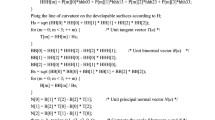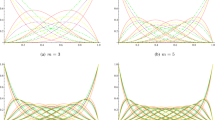Abstract
Development of curved surface is a useful tool in CAD (computer aided design) and CAGD(computer aided geometric design). This paper presents the algorithms for developing (flattening) a smooth continuous curved surface embedded in three-dimensional space into a planar shape. First the definition of planar development of a curved surface is presented, and the distortions (at length and area) of development are discussed in this paper. Then several planar flattening methods of curved surface, and their advantages and disadvantages are analyzed in detail. For NURBS(non-uniform rational basic spline) surfaces, which are broadly used in CAGD, we put forward a new planar developing algorithm, i.e. hybrid developing, and present the steps of the algorithm. At last, some examples are used to show the effectiveness of the algorithm.
Similar content being viewed by others
References
Parida L, Mudur S. Constraint-satisfying planar development of complex[J]. Computer Aided Design, 1993,25 (4): 225–232.
Shimada T, Tada Y. Approximate transformation of an arbitrary curved surface into a plane using dynamic programming[J]. Computer Aided Design, 1991,23 (2): 153–159.
Shimada T, Tama Y. Development of curved surface using finite element method[A], Computer-Aided Optimum Design of Structures, Recent Advise[M]. Springer-Verlag, 1989: 23–30.
Chakib Benic, Jean-Marc Veien, Gerard Iglesias. Piece-wise surface flattening for non-distorted texture mapping [J]. ACM Computer Graphics, 1991,25(4): 237–246.
Phillip N Azariadis, Nikos A Aspragathos. On using planar developments to perform texture mapping on arbitrarily curved surfaces [J]. Computers & Graphics, 2000,24:539–554.
Xi Ping, Zhang Hang, et al. Geometric computation on development of non-regular punched parts[J]. Journal of Engineering Graphics, 1998 (3): 94–99 (in Chinese).
Mao Xin. Development and optimum developing point of curved surface[J]. Journal of Engineering Graphics, 1998 (2): 1–10(in Chinese).
Les Piegl. On NURBS: a survey [J]. IEEE Computer Graphics & Application, 1991, 23(3): 55–70.
Josef Hoscheck. Approximate of surface of revolution by developable surface[J]. Computer Aided Design, 1998, 30(10): 757–763.
Kruth J-P, et al. Reverse engineering modeling of free-form surface from point clouds subject to boundary conditions[J]. Journal of Materials Processing Technology, 1998, 76: 120–127.
Dimas E., et al. 3D geometric modeling based on NURBS: a review[J]. Advances in Engineering Surface, 1999,30: 103–106.
Park H., et al. A method for approximate NURBS curve compatibility based on multiple curve refitting[J]. Computer Aided Design, 2000,32: 237–252.
Wonjoon Chot, et al. Approximate development of trimmed patches for surface tessellation[J]. Computer Aided Design, 1998, 30(14): 1077–1087.
Helmut Pottmann, Johannes Wallner. Approximation algorithms for developable surfaces[J]. Computer Aided Geometric Design, 1999,16: 539–556.
Author information
Authors and Affiliations
About this article
Cite this article
Liang, WW., Bin, HZ. Research on planar development of curved surfaces. J. of Shanghai Univ. 7, 185–190 (2003). https://doi.org/10.1007/s11741-003-0089-5
Received:
Revised:
Issue Date:
DOI: https://doi.org/10.1007/s11741-003-0089-5




